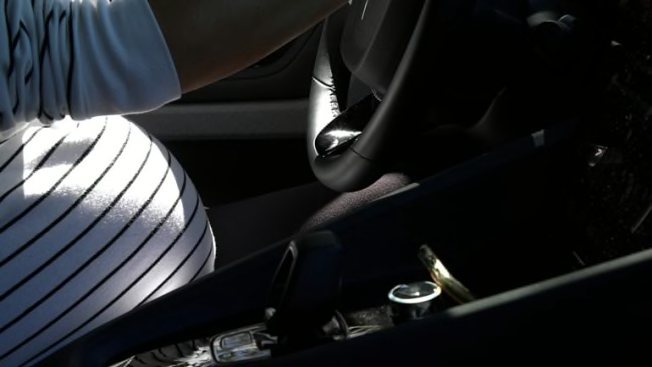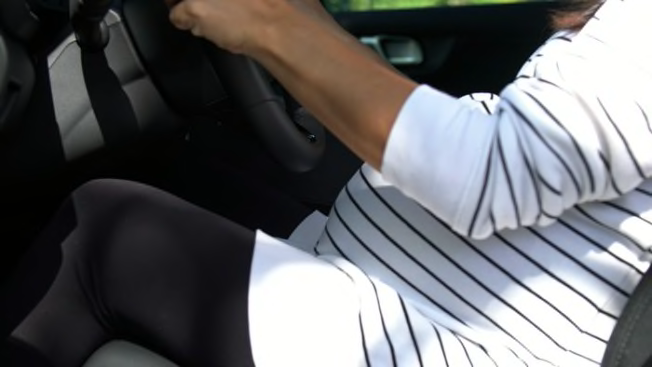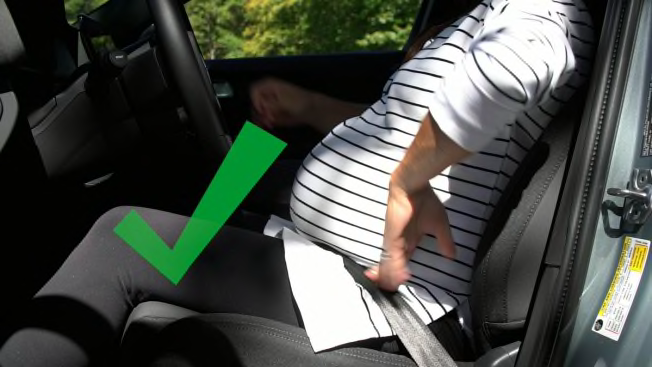Standard seat belts aren't designed for pregnancy but are still the best option. Here, CR's advice on the right way to wear a seat belt when you're expecting.

The correct way to buckle up when pregnant.
Photo: Anatoliy Shumskiy/Consumer Reports
It was a route Taylor and Ryan Olsen had driven countless times. They were rounding the bend on a backroad headed to Taylor’s mom’s house in Northern California, carrying precious cargo: the couple’s first child, a girl, who was due to be born in just five weeks. But on this day, in October 2015, a driver in another car blew past his stop sign and hit the front passenger side of the Olsens’ vehicle, near where Taylor was sitting. Taylor was wearing her seat belt, with the lap portion correctly positioned below her sizable pregnant belly. While the belt prevented her from being flung into the dashboard—she sustained only minor injuries—she was rushed to a hospital because the baby’s heart rate had dangerously slowed. Doctors performed an emergency C-section, and determined that the baby’s skull was fractured by the force of the impact of her body against the seat belt itself. “She lived for about 12 hours,” says Taylor of her daughter, named Bailey. “She passed away from the skull fracture.”
There’s More to This Story. And it’s YOU!
Your gift makes a difference in our work — from in-depth reporting on consumer issues to ensuring safer food and reliable products. Donate
Devastated, Taylor wondered why her seat belt hadn’t better protected her baby—and why that risk wasn’t on her radar. “I didn’t think about it because it’s not something that’s talked about all the time. I mean, people drive every day pregnant,” she says.
What About Seat Belt Adjusters?
Perhaps given automakers’ lack of attention to pregnant car occupants, several companies have developed aftermarket seat belt attachments for pregnant people to use in their cars. However, the government does not set standards for these devices or regulate them. As a result, none have been adequately crash-tested. That hasn’t stopped some companies, though, from making claims about their seat-belt adjusters for pregnant women For example, the maker of the MimiBelt, a seat belt adjuster that is meant to redirect the lap belt so it stays between the user’s thighs, say on its website that it has “NHTSA & ANCAP vehicle safety approval.” This implies that both the U.S.’s NHTSA and the Australasian New Car Assessment Program, which works in Australia and New Zealand, have endorsed the product. A MimiBelt spokesperson did not answer CR’s questions about the claims. But both the U.S. and Australian entities told CR that is not accurate. A spokesperson for NHTSA said the agency “does not have a safety standard that directly applies to belt positioning devices,” and added that aftermarket seat belt adjusters “do not fall under regulations, since they are neither installed as part of a completed vehicle nor as part of a seat belt assembly.” Similarly, a spokesperson for the ANCAP said it “does not set requirements for, or assess, aftermarket products or vehicle modifications,” and that seat belt adjusters have “not been tested or endorsed by ANCAP, and any claims by the manufacturer in relation to ANCAP endorsement are incorrect.” Another seat belt adjuster for pregnant people is called the Tummy Shield, which is sold by Colorado-based Safe Ride 4 Kids. The company does not claim that its product—a stainless steel plate and anchor that hooks the lap belt into a V-shape between the user’s legs—is approved by any government agency. But the company does say that its own testing found that the Tummy Shield withstood the impact of a simulated crash. Independent experts acknowledge that more needs to be done to protect pregnant women and fetuses in car crashes, and say that seat-belt adjusters might eventually play a role. For example, Duma, at Virginia Tech, says the devices might "be helpful especially because some women will tend to let the lap belt ride up a little too high...and if that gets too high, you put the load through the pregnant uterus, and that’s obviously not ideal." He notes that seat belt adjusters might also serve to remind women to properly position their seat belts under their bellies. Still, researchers also say that at this point there are too many unknowns about the aftermarket seat belt adjusters. “There are some circumstances where [the devices] could be helpful, but there are other instances where they could be misused or cause slack in the belt or cause redirected loading” of the forces of impact, says Klinich, at the University of Michigan. Lotta Jakobsson, a senior technical specialist at the Volvo Car Safety Center adds that “nobody has found a better solution” than the three-point seat belt, and messing up the parts of the seat belt can be problematic.” Thomas, at CR, agrees. “A non-regulated, aftermarket belt positioner could introduce slack into the seat belt system, increasing injury risk in a crash," she says.
What You Can Do
Though the three-point seat belt is not expressly designed for pregnant people, and the lap belt may press sharply against the pelvis in a crash, experts highly recommend that pregnant women wear a seat belt at all times in a car. The American College of Obstetricians and Gynecologists states that “you and your fetus are much more likely to survive a car crash if you are buckled in.” But it’s critical that you wear the seat belt correctly. To do so, follow these instructions:
Adjust the Seat
You should be in a comfortable, upright position with as much distance as possible between your belly and the steering wheel or dashboard.

Photo: Anatoliy Shumskiy/Consumer Reports
Adjust the Steering Wheel
If driving, be sure you can comfortably reach the steering wheel and pedals.

Photo: Anatoliy Shumskiy/Consumer Reports
Put the Seat Belt on Properly
Pull the shoulder belt across your chest (between your breasts) and away from your neck, not off your shoulder or behind it. Then position the lap belt underneath your belly.

Photo: Anatoliy Shumskiy/Consumer Reports
Adjust the Location of the Shoulder Strap
To reduce slack in the seat belt and ensure it lies flat against your chest, you may need to raise or lower the position of the shoulder belt.

Photo: Anatoliy Shumskiy/Consumer Reports
Position the Lap Belt Under Your Belly
The lap belt should fit snugly across your hips and pelvic bone—underneath your belly. That way, in the event of a crash, the strong bones in your hips and pelvis may partially absorb the impact of the crash.

Photo: Anatoliy Shumskiy/Consumer Reports
Don't Wear the Lap Belt Over Your Belly
That could harm your fetus in a crash.

Photo: Anatoliy Shumskiy/Consumer Reports
Note: Never disable the airbag. It is designed to work with the seat belt and can help prevent your head from crashing into the dashboard. Also keep in mind that if you don’t have to drive, it’s best to sit in the front passenger seat, and to push the seat as far back from the dashboard as possible. The back seat does not have the benefit of an airbag in most cars.


